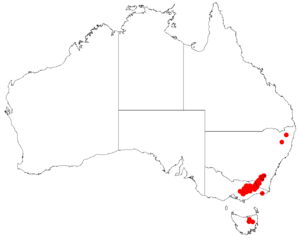Alpine mint bush facts for kids
Quick facts for kids Alpine mint bush |
|
|---|---|
 |
|
| On Mount Baw Baw | |
| Scientific classification | |
| Genus: |
Prostanthera
|
| Species: |
cuneata
|
 |
|
| Occurrence data from AVH | |
The Alpine mint bush (scientific name: Prostanthera cuneata) is a beautiful flowering plant. It belongs to the mint family, called Lamiaceae. This special bush only grows naturally in the mountains of south-eastern Australia. It's a neat, upright shrub with unique egg-shaped leaves. Its flowers are usually a pale lavender or almost white, often with pretty purple spots inside.
What it Looks Like
The Alpine mint bush is usually an upright shrub. It often grows to be about 0.5 m (1 ft 8 in) to 1.5 m (4 ft 11 in) tall. As it gets older, it might start to spread out closer to the ground. Its branches are roundish and covered with soft white hairs.
The leaves of this plant are very fragrant when you crush them. They are shaped like an egg, with the narrower part at the bottom. They are about 4 mm (0.16 in) to 6 mm (0.24 in) long and 3.5 mm (0.14 in) to 5 mm (0.20 in) wide. The leaves either sit directly on the stem or have a very short stalk, less than 0.5 mm (0.020 in) long.
The flowers grow one by one in the leaf corners near the ends of the branches. Each flower sits on a tiny stalk about 1 mm (0.039 in) to 2 mm (0.079 in) long. The green sepals (leaf-like parts that protect the bud) are often tinged with purple. They form a tube about 2.5 mm (0.098 in) to 3 mm (0.12 in) wide with two main parts.
The petals are usually pale lavender or almost white. They have reddish or purple blotches inside, which makes them look very pretty. The petals are about 9 mm (0.35 in) to 15 mm (0.59 in) long. They form a tube about 6 mm (0.24 in) to 8 mm (0.31 in) long. The lower part of the flower is about 6.5 mm (0.26 in) to 9 mm (0.35 in) long. The upper parts are about 5 mm (0.20 in) to 6 mm (0.24 in) long and have a small notch in the middle. This plant usually flowers from November to April.
How it Got its Name
The Alpine mint bush, Prostanthera cuneata, was first officially described in 1848. A botanist named George Bentham wrote about it in a book called Prodromus Systematis Naturalis Regni Vegetabilis.
The second part of its scientific name, cuneata, means "wedge-shaped." This refers to the shape of its leaves, which often look like a wedge.
Where it Grows
The Alpine mint bush grows in high mountain areas of New South Wales and Victoria, Australia. You can find it in open shrublands and heathlands, especially where the soil is made from granite. It often grows alongside snow gums, which are a type of eucalyptus tree.
Sadly, in Tasmania, this plant is thought to have disappeared. In New South Wales, it grows south from the Brindabella Range. In north-eastern Victoria, it grows at high altitudes, usually between about 1,500 m (4,900 ft) and 2,000 m (6,600 ft) above sea level.
Growing it in Gardens
People sometimes grow the Alpine mint bush in their gardens. It's a popular choice because it's quite hardy. The Royal Horticultural Society has even given it an Award of Garden Merit. This award means it's an excellent plant for gardens.
It can handle cold temperatures down to about -5°C to -10°C. This makes it suitable for many different climates, especially in areas like USDA hardiness zones 8 to 9.
See also
 In Spanish: Prostanthera cuneata para niños
In Spanish: Prostanthera cuneata para niños

